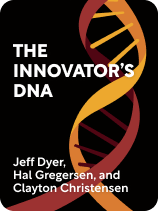

This article is an excerpt from the Shortform book guide to "The Innovator’s DNA" by Jeff Dyer, Hal Gregersen, and Clayton Christensen. Shortform has the world's best summaries and analyses of books you should be reading.
Like this article? Sign up for a free trial here.
Which of your skills should you focus on if you want to be a disruptive innovator? Do you network for ideas and brainstorm for questions?
Hal Gregersen, Jeff Dyer, and Clayton Christensen explore why innovation in business is so important. They outline the five behaviors and skills you can adopt to cultivate innovative thinking and explain how to drive meaningful change by embedding these behaviors and skills into your organizations and teams.
Continue reading for our overview of The Innovator’s DNA: Mastering the Five Skills of Disruptive Innovators.
Overview of The Innovator’s DNA
In today’s business environment, business leaders and companies must be innovative to stay relevant and succeed in the long term. In The Innovator’s DNA: Mastering the Five Skills of Disruptive Innovators, Hal Gregersen, Jeff Dyer, and Clayton Christensen argue that anyone can learn to innovate by practicing the five skills of the most successful innovators in the world, which they distilled from years of studies and interviews with roughly 100 innovative leaders and inventors of revolutionary products.
Gregersen is a professor of leadership and innovation at MIT and a co-founder of the Innovator’s DNA consulting group. Dyer is an award-winning Professor of Strategy at Brigham Young University and a widely respected management scholar whose research has been featured in publications like Forbes, the Economist, and the Wall Street Journal. Christensen, a business researcher and consultant, is regarded as one of the most influential business thinkers of all time.
Dyer and Christensen separately co-authored several other books that, along with The Innovator’s DNA, form a collection on business innovation. Christensen’s 1997 book, The Innovator’s Dilemma, introduces the theory of disruptive innovation and explains how mature companies can miss out on new, breakthrough technologies and markets. The Innovator’s Solution outlines a framework for creating and growing successful companies by focusing on disruptive innovation and identifying emerging customer needs. Dyer’s The Innovator’s Method discusses identifying, testing, and validating successful innovation ideas before bringing them to the market.
Innovation Is Key to Success
The authors write that innovation is the key to success in today’s business environment, and the key to innovation, in turn, is creative thinking. Successful innovators don’t possess an inherent creative power that most others lack. The authors’ research found no significant difference in the psychological traits of innovative versus non-innovative thinkers. This means that creative thinking emerges from how you behave. Therefore, you can learn to think more creatively by learning to act differently.
The authors focus on what they call disruptive innovation, which creates entirely new markets by radically diverging from established products, services, and processes (as opposed to innovation that only improves upon current ones). Disruptive innovation drives significant growth and creates value by transforming entire industries and bringing breakthrough solutions to customers.
The authors assert that innovation and creativity should be strategic priorities for success in your business. Today’s business environment is uncertain and volatile—fifty million new businesses are started worldwide each year, which means there’s more competition. As a business leader, you must develop the capacity for disruptive innovation in your processes, products, or services if you want your company to survive and thrive. And as an employee, you must develop and use innovation skills to stand out and rise through the ranks.
The Five Innovation Skills
So far, we’ve discussed how crucial creative thinking is to innovation, but what exactly is creative thinking? The authors describe five behaviors and skills—what they call Discovery Skills, but we’ll call Innovation Skills—that are most likely to generate creative ideas. These are associative thinking, questioning, observing, idea networking, and experimenting. The authors say that associative thinking is the most critical skill for innovation and that questioning, observing, idea networking, and experimenting feed into this ability.
The authors emphasize two points about the Innovation Skills: 1) You don’t need to master all five skills equally to be a successful innovator. Their research showed innovators did not equally excel in all five Innovations Skills but showed strength in an average of two skills. To get the most out of your effort and time, figure out which two skills you have a natural strength in and prioritize developing those. 2) That being said, to get the most out of these skills and optimize your creative output, don’t focus solely on two skills. Instead, try to engage with all five to some degree, as they all support and build on one another.
Now we’ll describe each of the five Innovation Skills and show how you can enhance them to be more innovative.
Associative Thinking
The authors argue that the core of creative thinking is associative thinking—drawing connections between seemingly unrelated things (questions, problems, concepts, and so on). Creative innovation rarely entails coming up with a completely novel idea. It’s more often about taking existing ideas and associating them with each other in new ways.
The authors’ research showed that business innovators discover creative ideas by connecting the dots between different industries, disciplines, technologies, and areas of expertise. They explain that the more diverse and expansive your mental library of knowledge is, the greater your chance of associating two ideas that lead to innovation. For this reason, innovative thinkers work to expand their mental libraries by seeking a wide variety of professional and personal experiences, like traveling outside their home countries and taking classes in unfamiliar subjects that pique their curiosity.
To think associatively, you must understand, organize, and store new knowledge and experiences you gain. You can improve these abilities by frequently questioning, observing, networking, and experimenting—the Innovation Skills.
Techniques for practicing association skills:
- Let your mind wander.
- Challenge your brain to associate. Practice making connections between things that may seem unrelated at first glance.
Questioning
Asking questions improves your associative thinking by helping you gather crucial information about the status quo and then imagining new connections, possibilities, and directions for radical change.
The authors’ research found that innovators not only asked more questions, they asked more disruptive questions—ones that challenged assumptions and looked at established products, services, and processes from new angles.
Particularly when you encounter a problem that requires a creative solution, like how to fill a gap in the market, it’s often more fruitful to spend time asking questions about the problem first rather than trying to come up with solutions right away. If you brainstorm solutions too early in the process, you may get stuck solving the wrong problems. When you ask the right questions, you’ll understand the dimensions of the problem much better, and then you’re set up to find the right creative solutions.
Techniques for Practicing Questioning Skills
The first technique involves asking four types of questions that will help you challenge the status quo:
- Defining Questions: These help you define and describe the current status of products, services, and processes. By understanding what is, you can imagine what could be.
- Origin Questions: These help you discover the real problem with a current product, service, or process and how it got to be what it is today.
- Limit-Testing Questions: These help you explore possibilities for improvement or ways to disrupt the status quo.
- Imagination Questions: These questions allow you to perform thought experiments by imagining things differently.
The second technique is to brainstorm for questions (an activity the authors call QuestionStorming). This exercise will strengthen your questioning skills and provoke deeper inquiries about the root causes or core elements of a problem. QuestionStorming involves coming up with a least 50 questions about the identified problem and then attempting to answer them only after you’ve listed and prioritized them.
Observing
Making careful observations is a crucial skill for connecting dots, asking questions, and prompting insights. By carefully observing current products, services, and business processes, innovators discover what works, what doesn’t, and where an innovative solution may be needed. Observing this way can spark new questions and allow you to think associatively as you discover the overlap between diverse data sets, unique situations, and differing industries.
Observe customers (your own or your competitors’) in different situations as they try to get something done, interact with technology, or use a service. By actively observing what works and doesn’t work for people, you may discover an unmet need, which could spark ideas for novel solutions. Keep an eye out for what the authors call workarounds—the often ingenious and unexpected methods people come up with to get things done using available products and services that lack some fundamental functions. Identifying a workaround presents an opportunity for you to replace it with a new and innovative product or service.
Techniques for building observation skills:
- Observe in new and unusual environments.
- Observe with all of your senses.
- Study other companies.
Idea Networking
The authors introduce the concept of networking for ideas, which means interacting with people you have little in common with as a way to generate and test new ideas. Networking for ideas is how innovators widen their perspectives, form links between concepts, learn new things about the world, and gain feedback from experts and non-experts about their new ideas. The authors assert that mingling and talking with people from radically different backgrounds, industries, and life experiences increases your ability to think associatively and creatively by expanding your worldview and creating more opportunities for you to network for ideas.
Techniques for building your idea network:
- Diversify your contacts.
- Follow your curiosity.
- Make plans to network.
Experimenting
The final Innovation Skill is to experiment with potential solutions to business problems. Experimenting leads to innovative business ideas because when innovators take things apart and test their ideas with prototypes and pilot projects, they discover new possibilities for products and services. In essence, experimenting is searching for answers to your Defining Questions—it’s best for gathering data about ideas that might work in the future, while questioning, observing, and networking provide data about the present and the past.
Techniques for experimenting with business ideas:
- Keep an open mind.
- Take things apart.
- Experiment with ideas by building prototypes.
- Test your ideas with pilot projects.
Develop Innovative Organizations and Teams
Now that we’ve looked at the skills you must develop to become an innovator, let’s see how you can apply those skills to build and sustain innovative organizations and teams.
The leaders and founders of innovative companies shouldn’t expect their employees to innovate on their own but instead help them innovate by embedding innovation into every level of their organizations—through team structures, workflows, and company mindset. Developing innovative capabilities at each level of your business is important because innovation leads to growth opportunities.
Team Structures
Optimize innovation in your organization by building and structuring your teams so that members have diverse perspectives and complementary Innovation Skills. To do this, you must hire the right people—look for potential hires with a track record of strong Innovation Skills and a passion for making big changes in the world. Prioritize candidates with expertise in different disciplines. Diverse perspectives from fields like sociology, psychology, engineering, and science foster associative thinking within an organization and contribute valuable insights into new products, services, and processes.
Once you have the right people, structure teams so that members’ Innovation Skills balance and complement each other. Find out who has strengths in which skills and make sure each Innovation Skill is represented in equal measure within a team. Paying attention to the balance of Innovation Skills in a team can make the difference between a consistently innovative team and one that struggles to think creatively and bring viable ideas to market.
Workflows
To implement workflows that encourage innovation, you must first model innovative behaviors to your team by frequently and visibly making associations, questioning, observing, networking, and experimenting. Then, develop processes that require or at least make it easy for people to use their skills. The authors outline various ideas for ways to systematize the use of Innovation Skills in your company:
- Institute the 5 Whys questioning system.
- Develop formal and informal networking opportunities to facilitate knowledge-sharing inside and outside the organization.
- Institutionalize experimentation through product testing, pilot projects, and “beta” product releases (which allow the public to try out new offerings and gather valuable feedback in the process).
Company Mindset
Innovative leaders must infuse their organizations and teams with a commitment to innovation. Company mindsets are most effective when they’re shared among everyone and believed in. The authors outline three core tenets you can adopt to support your employees in having the courage and ability to innovate:
- Prioritize funding for disruptive innovation.
- Promote the belief that innovation is everyone’s job.
- Embrace risk and expect mistakes.

———End of Preview———
Like what you just read? Read the rest of the world's best book summary and analysis of Jeff Dyer, Hal Gregersen, and Clayton Christensen's "The Innovator’s DNA" at Shortform.
Here's what you'll find in our full The Innovator’s DNA summary:
- The five key skills that are shared by the world's innovation leaders
- Why innovation in business is so important
- How to sustain innovative organizations and teams long term






